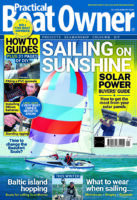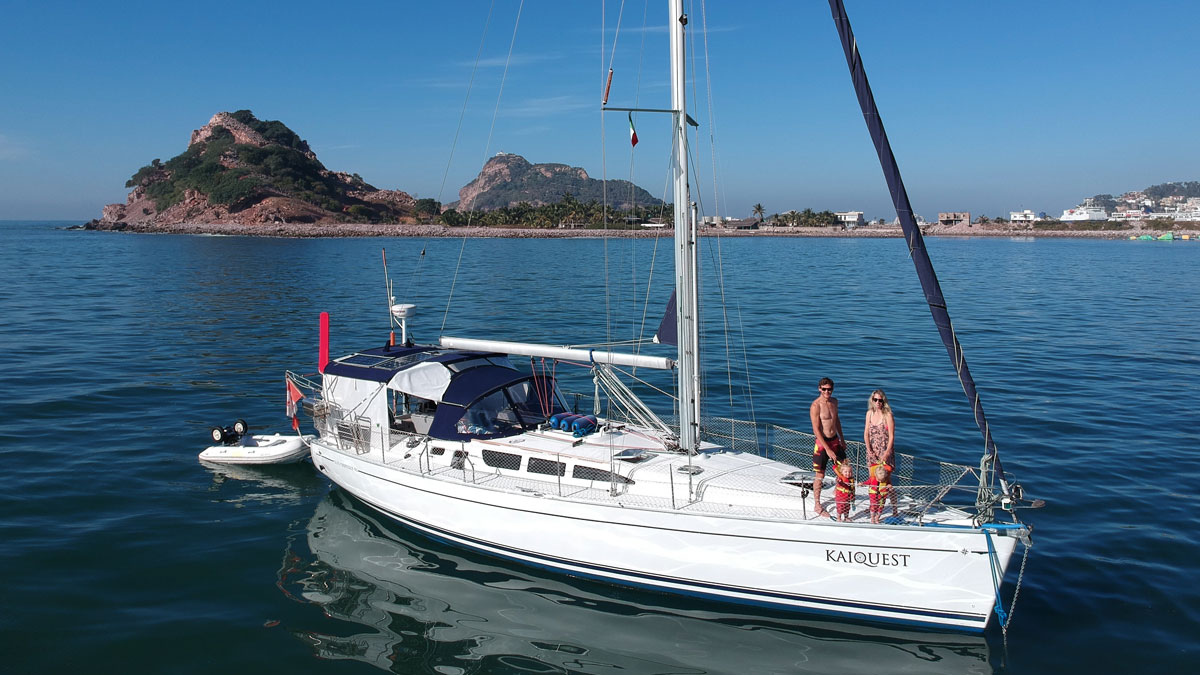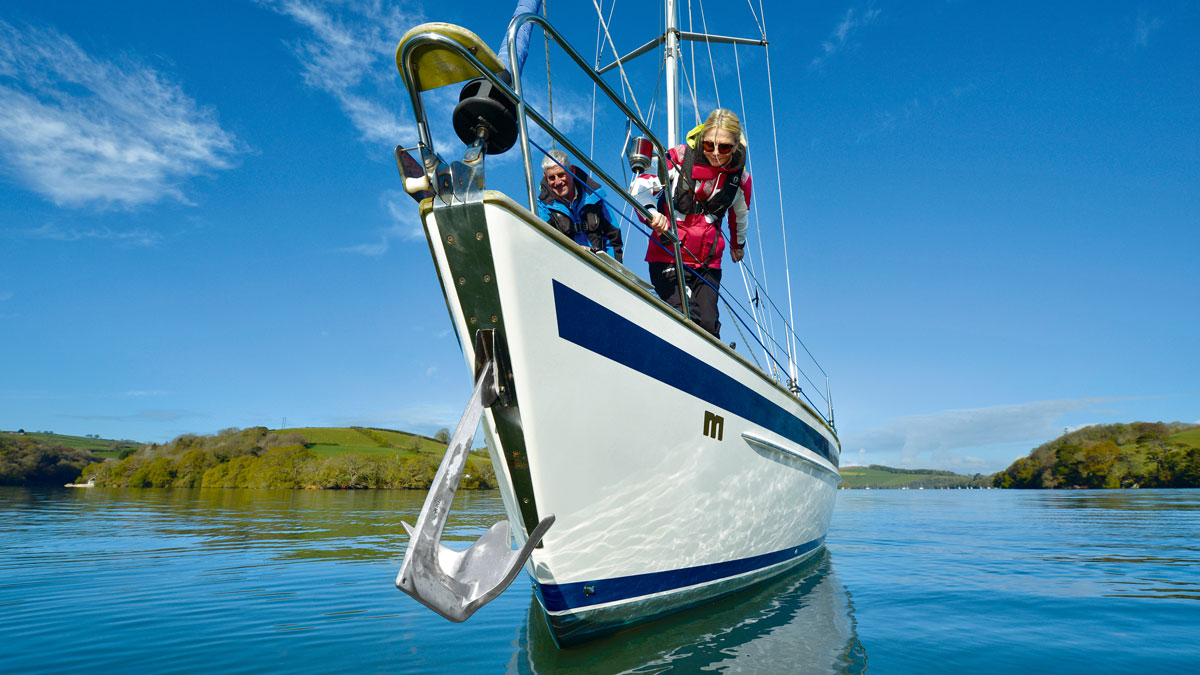"Sail south, now!": Ben Williams recalls narrowly escaping Hurricane Beryl as a novice sailor aboard his new 40ft catamaran.
When I bought my first boat, I didn’t imagine that I’d soon be sailing in a hurricane, writes Ben Williams.
The anchorage in Tyrell Bay was perfection. Good holding for the anchor, a beautiful setting and a great restaurant ashore. We were enjoying the peak of Caribbean sailing.
There was no sense of impending disaster. Many of the boats were being taken into the mangroves where the locals, both Grenadians and resident sailors alike, were confident that it would be safe and see out anything Hurricane Beryl could throw at us.
The day before I’d taken the dinghy into the mangroves to check them out and to see if we could stay there. As a complete newbie, the concept of using a shoreline to secure the boat at anchor sounded good.
I talked it over with our buddy boat, an excellent Texan family who’d recently circumnavigated. They weren’t going to go in there.
“We don’t have a stern anchor or enough extra lines to properly secure the boat, plus the real danger will be the other boats in there crashing into you”, they said. “We’re going to head to Trinidad”.
I thought about it and realised I didn’t have any of that stuff either. Maybe the mangroves were a bad idea after all.

The setting was idyllic – except for the forecast. Photo: Ben Williams.
Growing concern
My phone had two messages urging us to “Sail south, now!” It was the broker who had sold me the boat five weeks earlier, and the former owners, both with the same message. I looked at the sky. It was just another day in paradise.
The worry was building, though. For day,s we had seen countless boats sailing past, always south.
My plan for hurricane season had been to sail away from it, but many of the cruisers that we’d seen had told us this was not possible and that we needed to find a place for the boat. The weather reports had been unsure of the exact path Hurricane Beryl was takin,g and a lot of sailors were convinced it would turn north and miss us.
What should we do?
Soairse is a 40ft South African Island Spirit catamaran. It’s our first boat. We’d only been on the boat for five weeks, having bought her in Trinidad. To say we were newbies is an understatement.
We had sailed her to Tobago and then overnight to Grenada where we’d met the Texans, and since we both have teenagers and got on well, we tagged along with them. They were lovely, and we were learning loads from them.

Ben Williams ‘sold everything’ to buy his 40ft Island Spirit catamaran Saoirse in Trinidad. Photo: Ben Williams.
Time to go
New messages were still coming in, all saying the same thing: “Sail south now. Where are you?”
We had provisions and were ready to sail, apart from a stinking hangover from my birthday celebration at the aforementioned curry house the night before. The plan was to sail to Trinidad in one go, taking the windward side of Grenada, as it was more direct from Carriacou. The Texans were soon out of sight on their 2009 Leopard 46 but were keeping in touch thanks to Starlink.
With one reef in the main, we pulled anchor and went.
In between Carriacou and Grenada is an interesting and terrifying navigational hazard, Kick ‘em Jenny, an active underwater volcano with an exclusion zone. We were passing between this and some small islands.
The sailing was good with 15 knots on the beam and little swell. We passed a French monohull and were getting comfortable when, from out of nowhere, the wind jumped to 30 knots.
The boat surged forward, and the wheel strained against me as I battled the worsening conditions. The instruments were now reading 40-50 knots. The radar blew off the mast, bounced off the deck and disappeared into the sea. I turned into the wind to take the pressure off the sails. The sea was vicious and smashing into us from what felt like every direction.
Teamwork while sailing in a hurricane

Ben was proud of how his sons coped during testing sailing conditions. Photo: Ben Williams.
“Boys,” I shouted to my two teenagers, “Get the sails in quick!”.
They clipped onto the jacklines and got out front. I was so proud of them. They got the sails down in awful conditions with no issues or complaints. My wife was scared for them going out of the cockpit, but they were so sure with their movements, and they were clipped on and wearing quality lifejackets.
With the sails down and the motors on we battled against the squall. Without stressing the engine, we were managing one knot of movement south.
My main preparation for sailing had been a prodigious amount of reading, including stories of other sailors facing hurricanes. I was trying to recall if Larry Pardey had been slowly pushed over an underwater volcano while running from a hurricane or if Roger Taylor had seen his expensive equipment blown into the sea, picking up what I could from other long-haul cruisers.
This felt like a new and uniquely frightening situation. There was nothing to it but to sit tight and hope that things would calm down.

Photo: Ben Williams.
After what felt like an age but was only about 30 minutes, the boat started to make headway. The wind started dropping to less panic-inducing levels and, glory be, the sun came back out. The squall had passed. We got the sails back up and hurried past Kick ‘em Jenny and into the shadow of Grenada.
As we motor-sailed down, we heard from the Texans. They had been hit by the squall, but on the exposed Atlantic side just off the north tip of Grenada. They suffered no serious damage, but the waves had got up so they abandoned the plan of going to Trinidad in one go and sailed back up around the top of Grenada and followed us down the safer, calmer western shore.
Mass departure
It had been a hell of a day, and we were all exhausted. My wife wanted to carry on through the night, but we all needed sleep. We have no autopilot, and the sails cannot be single-handed. We decided to stop at St George. We got there about 2100 and managed to glide up to a mooring ball.
We had stayed here before, so we knew the anchorage and it was no problem in the dark. I slept outside in the cockpit, out of habit because it was so hot and I liked to see the stars. I woke at 0500 to another message:
“Sail south now. Beryl upgraded to a full hurricane and to hit Grenada.”
I looked out at the anchorage. Everyone was leaving. I got everyone up and ready and we got going.
“It felt like a race. Us against nature.”
The day was glorious. Eighteen knots of wind on a broad reach had us flying south. As we passed the headland that marked the southern point of Grenada we could see all the boats pouring out of the southern coast anchorages. There must have been 200 yachts fleeing. If not for the hurricane, you might think it was a regatta.
We were averaging 8 knots and the boat was sailing as well as she’d ever done. We caught two fish on our lines, and the sail was great. I kept looking back to see if I could see this monster system that was just getting worse with every update we got, but there was nothing to see. It was reassuring and a bit disappointing.
I’ve never been in or near a hurricane, and I was expecting a bit of drama. We crossed over to Trinidad and arrived at the small island of Chacachacare at 0830. It’s an abandoned leper colony that is rarely visited and is only nine miles from Venezuela. We had been a few times for day sails in the first week of owning the boat and had rarely seen anyone else in there.
There were 50 boats in the anchorage that night. I didn’t sleep. I was too pumped from the trip and the news.
Then the lightning came over like I had never seen before. I sat up praying no one would get hit.
The aftermath of sailing in a hurricane

Palm trees uprooted by Hurricane Beryl in St Patrick, Grenada, 2 July 2024. Photo: Associated Press / Haron Forteau / Alamy.
The next day, we started seeing the pictures and reports on social media. Tyrell Bay, where I’d thought to hide out in the mangroves, had been totally destroyed. Every boat in the mangroves was damaged, most beyond repair, and the two boatyards were wiped out. It was a good job we sailed south.
After the storm surge conditions calmed down, we made the short hop across to the Trinidad sailing club anchorage. There were so many boats that we were anchored quite far away but by pure chance, we found ourselves next to the Texans. There is a bar and a swimming pool there, and for a week, we chilled out and shared our stories with all the other escapees. We met a South African family and another American family who all had teenagers.
Trinidad is a wonderful place on land with incredible people and great provisioning, but the anchorages are horrible. Lots of debris in the water and very loud, party boats that go through the anchorages till 3am. There was a community there though of all the yachts that made it.
As boats started to head back north, we left with three other sailors and spent most of the summer in Grenada with them, thankfully without any other hurricanes to avoid.
Hurricane Beryl

Hurricane Beryl viewed from space. Photo: NASA Archive / Alamy.
According to the National Oceanic and Atmospheric Administration, from 28 June to 9 July 2024 Beryl was an aclimatologically early Cabo Verde hurricane, becoming the earliest category 5 (on the Saffir-Simpson hurricane wind scale) hurricane of record in the Atlantic basin. It passed through the Windward Islands as a major hurricane causing severe damage, and it later made landfall as a hurricane on the Yucatan Peninsula of Mexico and then the coast of Texas. The hurricane was directly responsible for 34 deaths. The strongest winds observed in the south-eastern Caribbean islands were from the Hewanorra International Airport on Saint Lucia, which reported sustained winds of 57 knots at 1139 UTC on 1 July and a peak gust of 72 knots.
Lessons learned from sailing in a hurricane

Rainbow after the storm. Photo: Ben Williams.
- Be on top of the weather. I was aware of the hurricane and had been following a weather channel on YouTube for updates. This is not enough. Without the people looking out for us there is a good chance we’d have been caught too close to the storm. Now I check the weather twice a day and have apps and websites for multiple opinions and forecasts.
- The second night in Chacachacare, an island in the Republic of Trinidad and Tobago, we were hit by a monster swell. I put my engines on and in gear to take some of the strain off the anchor bridle and to be ready if we dragged as we were being pushed towards shore. I did this instinctively but afterwards, I realised it was a good tactic. There was a lot of damage done in the aftermath of Beryl by this surge and I was not aware that it would be happening. Now I’m prepared for the following sea state after a storm.
- Since the storm, we have sailed much more conservatively. We were overpowered leaving Carriacou and the genoa was certainly too large. When the squall hit and I turned into the wind, it smashed the radar. Now I would turn away from the wind to shield the genoa with the mainsail to bring it in and then turn in to drop the main.
- It was my birthday but in hindsight, I should have delayed the party. Having to do what we did tired and hungover made it more difficult and potentially dangerous. I was not thinking ahead enough.
- Having a buddy boat was invaluable. We had made friends for life and gained so much from their round-the-world sailing knowledge, but having someone to speak with on the journey was a huge comfort. It’s not easy finding them, but when you do stick together.
Expert comment
Cruising doyen and founder of the original Atlantic Rally for Cruisers transatlantic rally, Jimmy Cornell comments:
I’d like to thank Ben Williams for sharing his tale, as there are some key lessons to be learned from it that could help other readers. What Ben and the other sailors fleeing Hurricane Beryl have done by attempting to sail south to a safe area as fast as possible was right. It was a good decision, it worked, and I am pleased that it had a happy ending.
In such situations, all that matters is the outcome, even if what actually happened is against my strict principle of ‘always attempting to be in the right place at the right time and avoid being in the wrong place at the wrong time’.
Hurricane Beryl occurred in late June, early July, well into the North Atlantic hurricane season (June to November), as did Hurricane Brett between 19 and 24 June 2023. Therefore, the decision to spend that season in a critical area should be considered very carefully, especially in these days of climate change. The devastation caused by Beryl proves that point.
In all my books and my tips on future-proofing your sailing, I stress that hurricane-prone areas should be left ideally by the end of April or early May, as there have been early hurricanes in the Caribbean even in the month of May. Anyone who intends to spend the hurricane season in the Caribbean should inform their insurance company, as it most probably will be against such a decision.
I wish Ben good luck with his liveaboard lifestyle, as I’d enjoyed for most of my sailing life. I believe that he is the perfect candidate to receive the ‘Cornell NOT TO award’, and I shall happily send him a copy of Cornells’ Ocean Atlas of pilot charts. The latest edition shows the location and extent of tropical storms for every month and in every ocean.
Ben Williams is a 46-year-old Yorkshireman who sold everything in 2023 and bought his first boat, a 40ft Island Spirit catamaran in Trinidad to become a liveaboard with his wife and two teenage sons. They are currently in Guadeloupe as they adopted a dog in Grenada, Georgia, and find the French islands to be much friendlier for pets as well as being excellent for food, drink, chandleries and locations. The Iles des Saintes off the south coast is their favourite place so far. Follow their travels on Instagram @Adventuresinsailing and @Georgiatheseadog.
How we live the dream: sailors share their routes into bluewater sailing
There are many paths to bluewater cruising. Here boat owners share their stories with Ali Wood ahead of their transatlantic…
Left for dead after falling overboard: how one sailor survived 5 hours lost at sea before rescue
Roger Cottle was presumed dead after falling overboard a 27ft yacht and lost at sea for five-and-a-half hours in a…
The best boat anchor types for different types of cruising & their pros and cons
Rupert Holmes looks at the different anchor designs and how to choose the right one for your type of cruising
Snap, shackle and drop: coping with a dismasted sailing yacht
Steve Hodges and his fiancée Sam McClements’ second attempt at the RYA Yachtmaster Ocean passage is scuppered by a dismasted…
Want to read more articles like this?

A subscription to Practical Boat Owner magazine costs around 40% less than the cover price.
Print and digital editions are available through Magazines Direct – where you can also find the latest deals.
PBO is packed with information to help you get the most from boat ownership – whether sail or power.
-
-
-
- Take your DIY skills to the next level with trusted advice on boat maintenance and repairs
- Impartial, in-depth gear reviews
- Practical cruising tips for making the most of your time afloat
-
-
Follow us on Facebook, Instagram, TikTok and Twitter








